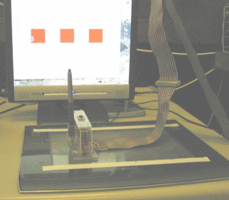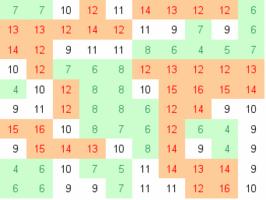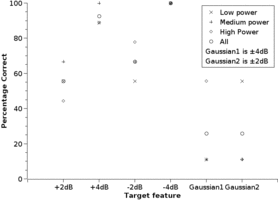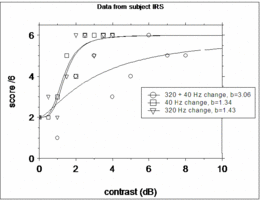Discrimination of tactile rendering on virtual surfaces
Introduction

An array of vibrating contactors on the fingertip can provide information about virtual objects during active exploration of a virtual environment - for example,
information about contact area, edges, corners and surface texture. The aim of this study is to investigate the discrimination of the virtual textures which can
be produced in this way, with the aim of developing a library of textures for use in virtual reality applications. Experimental questions include the number of
categories (i.e., frequency/amplitude/spatial combinations) that can be distinguished and the possible correspondence between virtual and real textures.
The tactile stimulator used for this study is a device developed for the HAPTEX project on virtual textiles
- Vibrotactile stimulation is provided by a 6 × 4 array of contactors with 2 mm pitch. Each contactor is driven by a
piezoelectric bimorph, under independent computer control.
- The drive waveform is specified as a superposition of up to eight sinewaves. Two sinewave components are used
in the present study: 40 Hz and 320 Hz.
- Position within the 2D workspace are provided by an A4 graphics tablet at an update rate of 40 Hz.
The visual representation (top left in the figure) is at 1:1 scale with the tactile workspace.
- The 2D workspace contains three square targets, each 40 mm × 40 mm. When the cursor lies within a target, the fingertip is presented with a texture,
specified by an amplitude map for 40 Hz stimulation and an amplitude map for 320 Hz stimulation.
Experiments

Example of a random surface.
A pilot study was performed with 9 subjects (5 female, 4 male).
Stimulation was at 40 Hz only, and the target specifications were:
- uniform amplitude distribution within each target, contrast in overall
amplitude of 2 dB or 4 dB
- contrast between uniform amplitude distribution and non-uniform
distribution (gaussian, range ± 2 dB or ± 4 dB).
In a follow up study, a experienced single subject attempted to discriminate
between amplitude contrasts of as little as 0.5 dB at 40 Hz and 320 Hz, and
to discriminate between mixtures of 40 Hz and 320 Hz at constant subjective
amplitude.
The numbers represent amplitudes,
expressed in dB above a nominal
perceptual threshold, and fit a
Gaussian distribution with a
Standard Deviation of 2 dB
Results and discussion

Pilot study scores for all 9 subjects, grouped by target type

Single subject scores from follow-up test,
showing amplitude contrast at 40 Hz
and 320Hz, and frequency contrast
In the follow-up experiment, for discrimination of amplitude change
in one component of a two-frequency stimulus, the experienced
subject scored at around 67% for 1.5 dB change of either the 40 Hz
or 320 Hz component. For discrimination of changes in frequency
balance at constant subjective amplitude, the subject scored at
around 67% for 3.0 dB increase of one component accompanied
by 3.0 dB increase of the other.
For spatial contrasts, inexperienced subjects scored mostly at
chance. Experienced subjects made use of an exploratory motion,
and reported that the non-uniform target felt "rougher".
An interesting observation is the strong interaction between the
spatial aspects of the texture and the stimulation frequency.
References
- Allerkamp, D., Böttcher, G., Wolter, F-E., Brady, A.C., Qu, J., Summers, I.R. (2006). A vibrotactile approach to tactile rendering,
The Visual Computer (in press).
- Summers, I.R. Chanter, C.M. (2002). A broadband tactile array on the fingertip.
Journal of the Acoustical Society of America, 112, 2118-2126.
- Summers, I.R., Chanter, C.M., Southall, A.L., Brady, A.C. (2001). Results from a Tactile Array on the Fingertip.
Proc. Eurohaptics 2001, Birmingham, 26-28.
Acknowledgements
This work was supported by the FET/IST initiative of the EU,
(
ENACTIVE Network of Excellence and the
HAPTEX project).
and was presented at the ENACTIVE 2006 conference in Montepellier.


 Example of a random surface.
Example of a random surface. 

